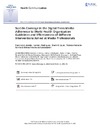Identificador persistente para citar o vincular este elemento:
https://accedacris.ulpgc.es/jspui/handle/10553/70021
| Título: | Suicide Coverage in the Digital Press Media: Adherence to World Health Organization Guidelines and Effectiveness of Different Interventions Aimed at Media Professionals | Autores/as: | Acosta, Francisco J. Rodríguez, Carlos J. Cejas, María R. Ramallo Fariña, Yolanda Fernandez-Garcimartin, Helena |
Clasificación UNESCO: | 320105 Psicología clínica 3211 Psiquiatría |
Palabras clave: | Suicide Digital press World Health Organization |
Fecha de publicación: | 2020 | Publicación seriada: | Health Communication | Resumen: | This study evaluated the characteristics of suicide news articles in the digital press, their adherence to World Health Organization (WHO) recommendations, and the effectiveness of interventions. We assessed adherence, avoidability, frequency and typology of suicide news over a six-month period in the four main digital media outlets of the Canary Islands (Spain). A brief training and information package intervention to the Canary Islands media outlets was carried out. We compared the quality of media reporting at both the pre-intervention and post-intervention timepoints, and compared the quality of reporting at the post-intervention timepoint in Victoria (Australia), where media interventions have been well-resourced and running for several years. We evaluated 339 suicide news articles: 38 from the pre-intervention period, 64 from the post-intervention period, and 237 from Victoria. News articles showed a very low degree of adherence to WHO recommendations, especially to those recommendations thought to have a protective effect. Post-intervention news articles showed better adherence than pre-intervention ones, but lower than those of Victoria, where constant interventions have been developed for years. We conclude that adherence to WHO recommendations is low. Simple interventions aimed at media professionals can improve adherence. However, constant and complex interventions seem to be more effective. | URI: | https://accedacris.ulpgc.es/handle/10553/70021 | ISSN: | 1041-0236 | DOI: | 10.1080/10410236.2019.1654176 | Fuente: | Health Communication [ISSN 1041-0236], v. 35(13), p. 1623-1632 |
| Colección: | Artículos |
Citas SCOPUSTM
21
actualizado el 08-jun-2025
Citas de WEB OF SCIENCETM
Citations
18
actualizado el 08-jun-2025
Visitas
109
actualizado el 01-mar-2025
Descargas
578
actualizado el 01-mar-2025
Google ScholarTM
Verifica
Altmetric
Comparte
Exporta metadatos
Los elementos en ULPGC accedaCRIS están protegidos por derechos de autor con todos los derechos reservados, a menos que se indique lo contrario.
